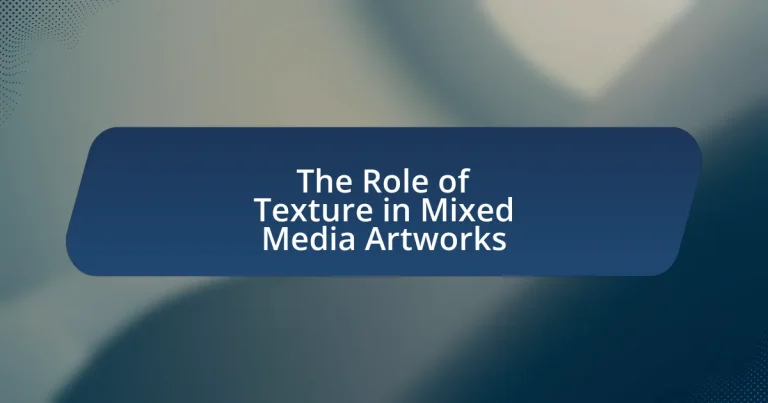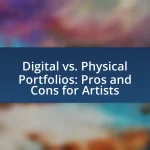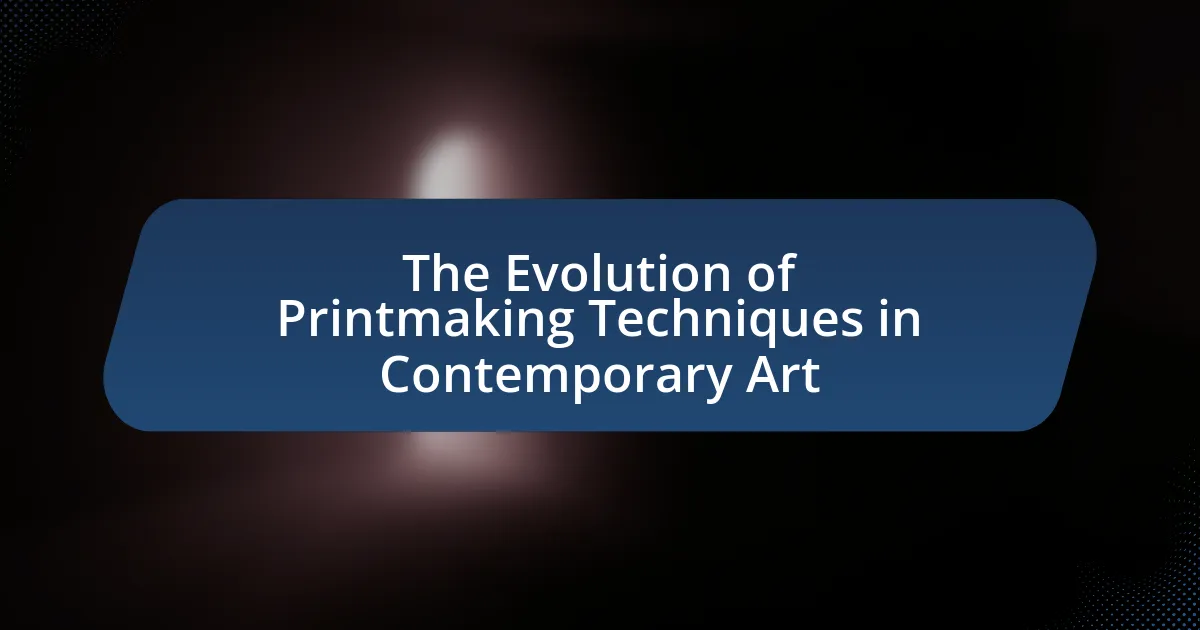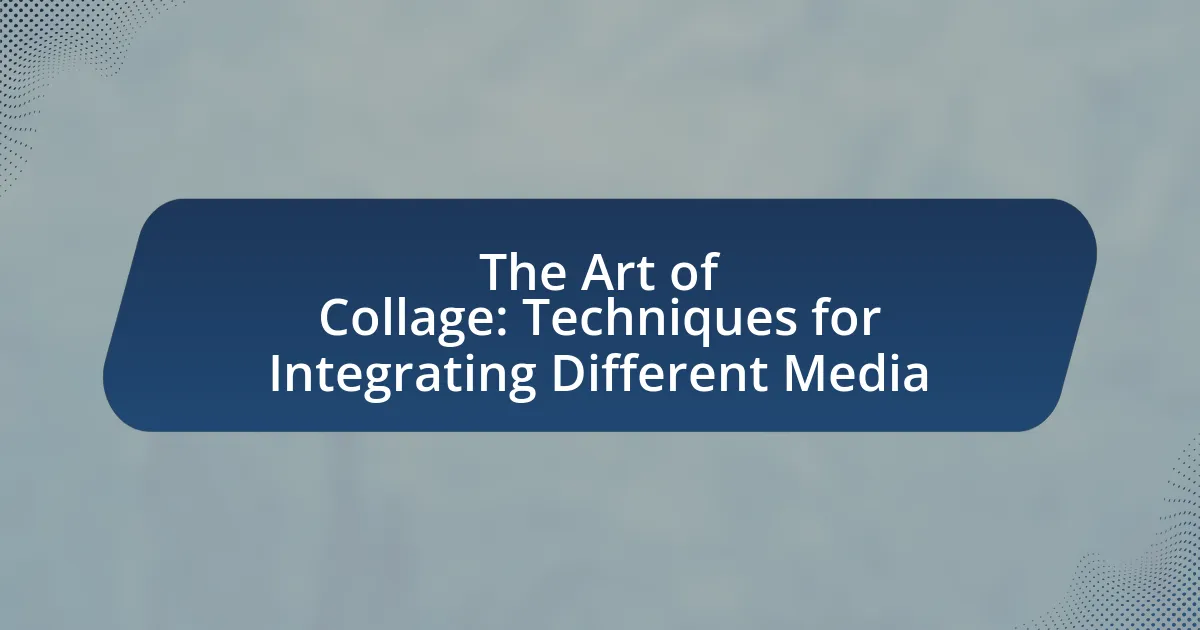The article examines the critical role of texture in mixed media artworks, highlighting how it enhances visual interest, depth, and viewer engagement. It discusses the influence of texture on overall composition, emotional responses, and the narrative conveyed by the artwork. Various types of textures, including rough, smooth, layered, and three-dimensional, are explored, along with techniques artists use to create and manipulate these textures. The article also addresses the challenges artists face when working with texture and offers best practices for maintaining harmony and integrity in their creations. Additionally, it provides resources for artists seeking to improve their textural techniques.
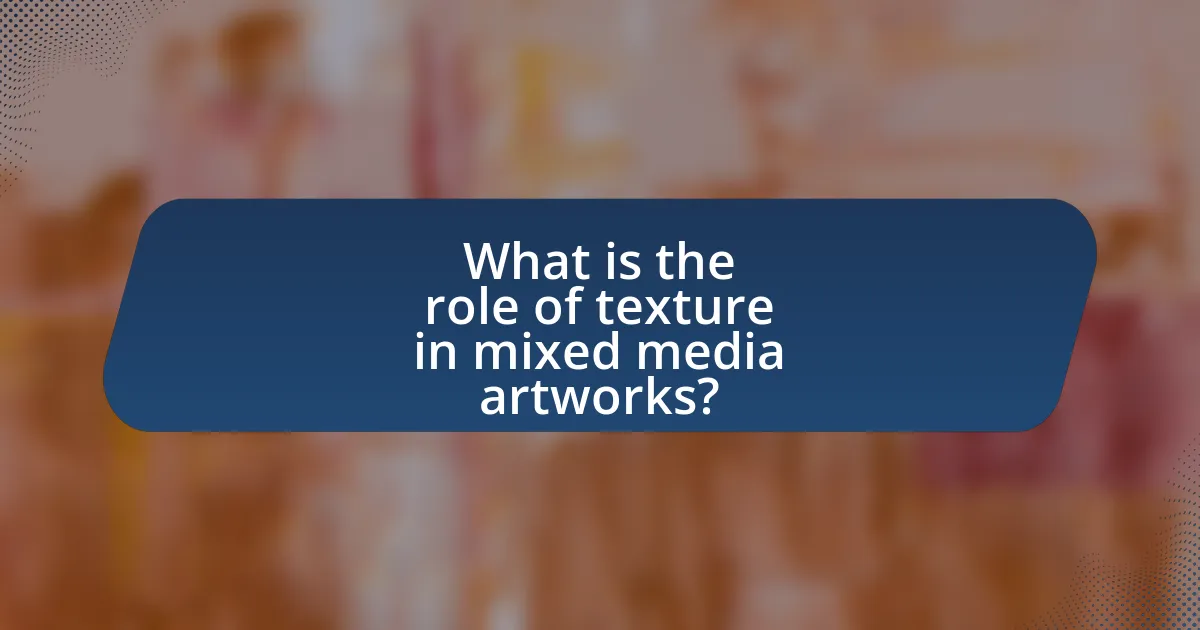
What is the role of texture in mixed media artworks?
Texture plays a crucial role in mixed media artworks by enhancing visual interest and depth. It allows artists to create a tactile experience that engages viewers on multiple sensory levels. For instance, the combination of various materials such as paper, fabric, and paint can produce contrasting textures that draw attention and evoke emotional responses. Research indicates that texture can influence perception; studies show that artworks with varied textures are often perceived as more dynamic and engaging compared to those with uniform surfaces. This interplay of textures not only contributes to the aesthetic quality of the artwork but also communicates the artist’s intent and narrative more effectively.
How does texture influence the overall composition of mixed media artworks?
Texture significantly influences the overall composition of mixed media artworks by adding depth, contrast, and visual interest. The incorporation of various materials, such as fabric, paper, and paint, creates tactile experiences that engage viewers and enhance the narrative of the artwork. For instance, artists like Robert Rauschenberg utilized texture to juxtapose smooth and rough surfaces, which not only draws attention but also evokes emotional responses. This interplay of textures can guide the viewer’s eye across the piece, establishing focal points and enhancing the overall aesthetic. Additionally, texture can convey meaning; for example, rough textures may suggest chaos or struggle, while smooth textures might evoke calmness or serenity. Thus, texture is a critical element that shapes the viewer’s perception and interpretation of mixed media artworks.
What types of textures are commonly used in mixed media art?
Commonly used textures in mixed media art include rough, smooth, layered, and three-dimensional textures. Rough textures can be created using materials like sand, fabric, or paper, adding tactile interest and depth to the artwork. Smooth textures often come from paint or glossy surfaces, providing contrast to rough elements. Layered textures are achieved by combining various materials, such as collage elements, which create visual complexity. Three-dimensional textures arise from the use of sculptural elements or found objects, enhancing the physical presence of the artwork. These textures contribute to the overall sensory experience and visual narrative of mixed media pieces.
How do different textures affect viewer perception?
Different textures significantly influence viewer perception by evoking emotional responses and altering the interpretation of visual art. Textures can create a sense of depth, movement, or tactile engagement, which enhances the overall experience of the artwork. For instance, rough textures may evoke feelings of discomfort or rawness, while smooth textures often convey calmness and serenity. Research indicates that viewers are more likely to engage with artworks that incorporate varied textures, as these elements stimulate sensory exploration and cognitive processing. A study published in the journal “Psychology of Aesthetics, Creativity, and the Arts” by authors Hagtvedt and Brasel (2016) found that textured surfaces can enhance the perceived value of an artwork, leading to a more profound appreciation and emotional connection.
Why is texture important in conveying meaning in mixed media artworks?
Texture is important in conveying meaning in mixed media artworks because it enhances the sensory experience and emotional impact of the piece. The tactile quality of different materials can evoke specific feelings or associations, influencing how viewers interpret the artwork. For instance, rough textures may suggest struggle or chaos, while smooth textures can convey calmness or serenity. Research indicates that texture can significantly affect viewer perception and engagement, as demonstrated in studies where participants reported stronger emotional responses to artworks with varied textures compared to those with uniform surfaces. This interplay between texture and meaning is crucial for artists aiming to communicate complex ideas and emotions through their work.
How can texture evoke emotions in the audience?
Texture can evoke emotions in the audience by creating sensory experiences that resonate with personal memories and feelings. For instance, rough textures may elicit feelings of discomfort or tension, while smooth textures can evoke calmness and serenity. Research indicates that tactile experiences influence emotional responses; a study published in the journal “Psychological Science” by Hagtvedt and Brasel (2016) found that individuals exposed to textured surfaces reported stronger emotional reactions compared to those who interacted with smooth surfaces. This demonstrates that the physical characteristics of texture play a significant role in shaping the emotional landscape of mixed media artworks.
What role does texture play in storytelling within mixed media art?
Texture plays a crucial role in storytelling within mixed media art by enhancing emotional depth and sensory engagement. Artists utilize various materials and techniques to create texture, which can evoke specific feelings or memories, thereby enriching the narrative. For instance, rough textures may convey struggle or chaos, while smooth surfaces can suggest calmness or serenity. This tactile quality invites viewers to engage more intimately with the artwork, allowing them to interpret the story on a personal level. Research indicates that texture can significantly influence viewer perception and emotional response, as demonstrated in studies on sensory interaction in visual art.
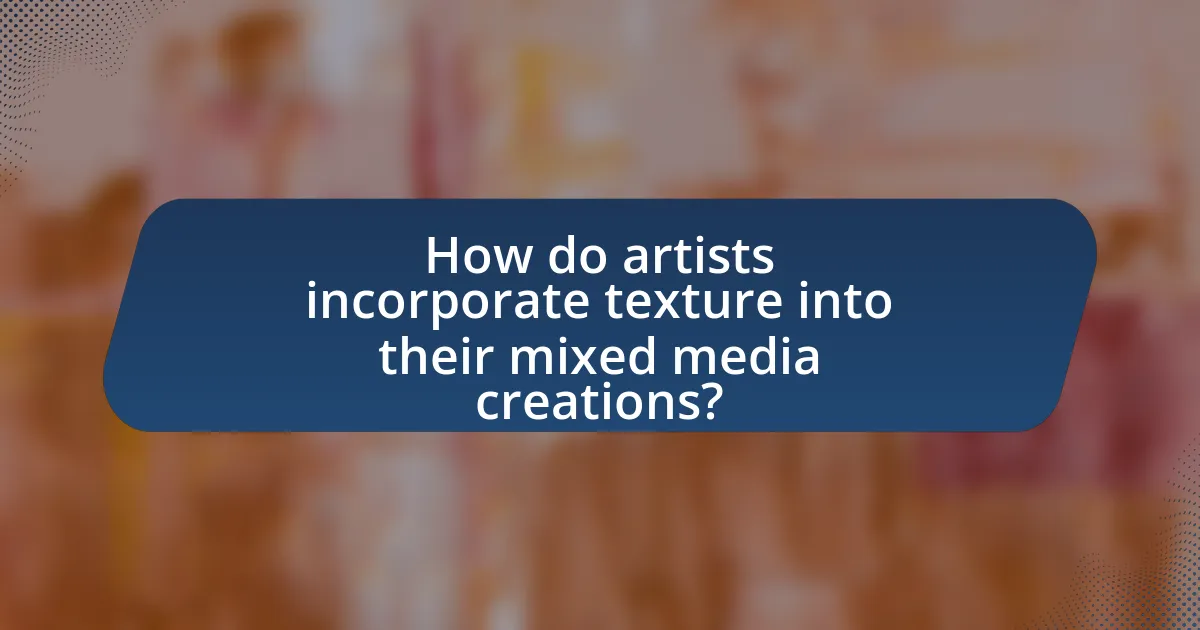
How do artists incorporate texture into their mixed media creations?
Artists incorporate texture into their mixed media creations by layering various materials such as fabric, paper, paint, and found objects to create depth and tactile interest. This technique allows artists to engage viewers not only visually but also physically, as textures can evoke emotional responses. For instance, the use of rough materials like sand or burlap can contrast with smooth surfaces like glass or metal, enhancing the overall sensory experience of the artwork. Additionally, artists often apply techniques such as collage, impasto, or the use of gels and pastes to manipulate surface texture, further enriching their compositions. This multifaceted approach to texture is essential in mixed media art, as it contributes to the narrative and thematic elements of the piece.
What techniques do artists use to create texture in their works?
Artists use various techniques to create texture in their works, including layering, impasto, and the use of mixed media materials. Layering involves applying multiple layers of paint or other materials to build depth and complexity, while impasto refers to the thick application of paint that creates a three-dimensional effect on the canvas. Additionally, artists often incorporate materials such as sand, fabric, or paper to enhance tactile qualities and visual interest. These methods are widely recognized in art history, with examples seen in the works of artists like Vincent van Gogh, who utilized impasto to convey emotion and movement, and contemporary mixed media artists who blend diverse materials to achieve unique textures.
How can layering materials enhance texture in mixed media art?
Layering materials enhances texture in mixed media art by creating depth and complexity that engages the viewer’s senses. This technique allows artists to combine various elements, such as paper, fabric, paint, and found objects, resulting in a rich tactile experience. For instance, the juxtaposition of smooth and rough surfaces can evoke emotional responses and draw attention to specific areas of the artwork. Additionally, layering can create visual interest through contrasting colors and patterns, which further enhances the overall aesthetic. The use of multiple materials also allows for the incorporation of different techniques, such as collage and assemblage, which contribute to a dynamic and multifaceted texture.
What tools and materials are essential for achieving desired textures?
Essential tools and materials for achieving desired textures in mixed media artworks include various brushes, palette knives, sponges, and textured surfaces such as canvas or wood. Brushes allow for different stroke techniques, while palette knives enable the application of thick layers of paint or paste, creating depth. Sponges can produce unique patterns and textures when dabbed or dragged across the surface. Textured surfaces, like canvas with a rough weave or wood with natural grain, contribute to the overall tactile experience of the artwork. These tools and materials are fundamental in manipulating the visual and physical qualities of the artwork, enhancing its complexity and engagement.
How does the choice of materials impact the texture in mixed media artworks?
The choice of materials significantly impacts the texture in mixed media artworks by introducing diverse tactile qualities and visual effects. Different materials, such as paper, fabric, metal, and paint, each contribute unique textures; for instance, rough surfaces from sandpaper or smooth finishes from acrylics can create contrasting effects that enhance the overall composition. Additionally, layering various materials can produce depth and complexity, as seen in works by artists like Robert Rauschenberg, who utilized found objects to create rich, textured surfaces. This interplay of materials not only influences the aesthetic appeal but also affects the viewer’s sensory experience, making texture a crucial element in mixed media art.
What are the effects of using natural versus synthetic materials on texture?
Using natural materials typically results in a more varied and organic texture, while synthetic materials often provide a smoother and more uniform texture. Natural materials, such as wood, cotton, and clay, exhibit unique imperfections and irregularities that contribute to a tactile richness and depth in mixed media artworks. In contrast, synthetic materials like plastics and acrylics can create sleek surfaces that may lack the nuanced feel of their natural counterparts. Studies have shown that the choice of material significantly influences the viewer’s perception and emotional response to the artwork, with natural textures often evoking a sense of warmth and authenticity, while synthetic textures can convey modernity and precision.
How do different mediums interact to create unique textures?
Different mediums interact to create unique textures by combining their physical properties, such as viscosity, absorbency, and drying times, which results in varied surface effects. For instance, when acrylic paint is layered over oil pastels, the oil’s smoothness contrasts with the acrylic’s matte finish, creating a tactile difference. Additionally, the interaction between water-based and oil-based mediums can lead to interesting textures, as watercolors can be absorbed by paper while oils remain on the surface, allowing for a dynamic interplay of layers. This layering technique is supported by artists like Robert Rauschenberg, who famously utilized mixed media to explore texture, demonstrating that the combination of different materials can yield innovative and complex visual experiences.

What are the challenges artists face when working with texture in mixed media?
Artists face several challenges when working with texture in mixed media, including the difficulty of achieving cohesion among diverse materials. The integration of various textures can lead to visual dissonance if not carefully managed, as different materials may have contrasting properties, such as weight, absorbency, and finish. Additionally, artists must navigate the technical challenges of adhesion and compatibility, as some materials may not bond well with others, risking the integrity of the artwork. Furthermore, the unpredictability of how different textures interact during the creative process can complicate the intended outcome, requiring artists to adapt and modify their techniques.
How can artists overcome common texture-related issues?
Artists can overcome common texture-related issues by experimenting with various materials and techniques to achieve desired effects. For instance, incorporating different mediums such as gels, pastes, or layering techniques can enhance texture and resolve issues like flatness or lack of depth. Research indicates that artists who utilize mixed media approaches often find innovative solutions to texture challenges, as evidenced by the work of contemporary artists who blend paint with fabric or found objects to create dynamic surfaces. This adaptability allows artists to address texture-related problems effectively, leading to more engaging and visually rich artworks.
What are the best practices for maintaining texture integrity during the creation process?
To maintain texture integrity during the creation process, artists should use consistent materials and techniques throughout their work. This practice ensures that the textures interact harmoniously, preventing discrepancies that could disrupt the overall aesthetic. For example, using the same type of paint or adhesive across different layers helps maintain a uniform texture. Additionally, applying textures in a controlled manner, such as layering and allowing adequate drying time between applications, preserves the intended visual and tactile qualities. Research indicates that artists who adhere to these methods report higher satisfaction with the final texture of their mixed media artworks, reinforcing the importance of these best practices.
How can artists effectively combine contrasting textures without losing harmony?
Artists can effectively combine contrasting textures without losing harmony by establishing a cohesive color palette and using a unifying element, such as a common theme or motif. This approach allows different textures to complement each other rather than clash. For instance, when an artist uses a warm color scheme across both smooth and rough textures, it creates visual continuity. Additionally, balancing the scale and placement of textures can enhance harmony; larger, rough textures can be offset by smaller, smooth ones to create a dynamic yet cohesive composition. Research in art theory supports this, indicating that visual balance is crucial for maintaining harmony in mixed media artworks.
What tips can enhance the use of texture in mixed media artworks?
To enhance the use of texture in mixed media artworks, artists should experiment with various materials and techniques. Incorporating elements such as fabric, sand, or found objects can create diverse tactile experiences. Additionally, layering different mediums, like paint over collage, adds depth and complexity to the artwork. Using tools like palette knives or sponges can manipulate paint texture effectively. Historical practices, such as those seen in the works of artists like Robert Rauschenberg, demonstrate the impact of combining textures to evoke emotional responses and visual interest.
How can experimentation with texture lead to innovative artistic expressions?
Experimentation with texture can lead to innovative artistic expressions by allowing artists to explore new sensory experiences and visual dynamics. By manipulating materials such as fabric, paper, or found objects, artists can create unique tactile surfaces that engage viewers on multiple levels. For instance, the use of mixed media techniques, as seen in the works of artists like Anselm Kiefer, demonstrates how layering different textures can evoke emotional responses and challenge traditional perceptions of art. This approach not only enhances the aesthetic quality of the artwork but also encourages interaction and interpretation, ultimately pushing the boundaries of artistic expression.
What resources are available for artists looking to improve their textural techniques?
Artists looking to improve their textural techniques can utilize a variety of resources, including online courses, workshops, instructional books, and video tutorials. Online platforms like Skillshare and Udemy offer courses specifically focused on textural techniques in mixed media art, allowing artists to learn from experienced instructors. Workshops conducted by local art studios or community colleges provide hands-on experience and direct feedback from professionals. Instructional books such as “The Art of Texture” by Kira K. and “Mixed Media Techniques” by K. M. offer in-depth insights and practical exercises. Additionally, YouTube hosts numerous video tutorials that demonstrate various textural techniques, enabling artists to visually learn and practice at their own pace. These resources collectively enhance an artist’s ability to experiment with and master texture in their artworks.
